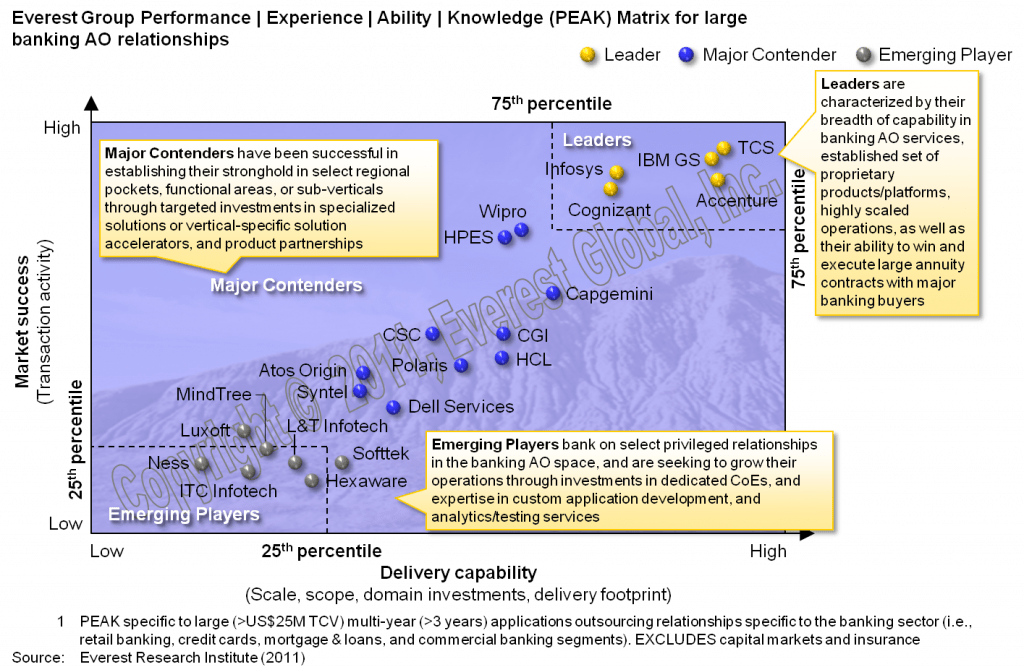
Per our observations of the evolution of the service provider landscape before and after the recession, the single most important factor we have seen for creating differentiation in the IT applications outsourcing (AO) market is significant strengthening of vertical/domain expertise. And recognizing the need for “vertical-specificity” in the AO market, earlier this year we launched an annual research initiative focused on assessing market trends and service provider capabilities for AO in the banking, financial services, and insurance (BFSI) vertical.
One of the first results that emerged from this research initiative was the Everest Group PEAK Matrix for large banking AO contracts. In a research study released earlier this week, we analyzed the landscape of AO service providers specific to the banking sub-vertical. In a world in which everyone and their uncle delivers AO services to financial services clients, this report examines 22 service providers and establishes the Leaders, Major Contenders, and Emerging Players in the banking AO market.
As we congratulate the five Leaders (Accenture, Cognizant, IBM, Infosys, and TCS), and acknowledge the capabilities and achievements of the Major Contenders and Emerging Players, we also want to highlight three inter-related market themes that suggest the PEAK Matrix in 2012 for large banking AO relationships may look significantly different:
Buyer-driven portfolio consolidation: Most banks currently use a complex collection of service providers for their applications portfolio. Decentralized decision-making, global expansion, and large-scale M&A introduced further complexity into their portfolios. Rationalizing the portfolio creates a less complex sourcing environment, enables strategic partnerships with service providers, and also delivers meaningful financial benefit (our analysis indicates that the financial benefits of utilizing fewer service providers can be as much as 22-28 percent on an annualized basis). As more buyers join the portfolio consolidation bandwagon, the larger/more established service providers are winning at the expense of their smaller competitors.
The Matthew effect: Buyer-driven portfolio consolidation is giving rise to the Matthew effect which (in sociology) states that, “the rich get richer and the poor get poorer.” In the context of the banking AO landscape, the Matthew effect translates to “the big get bigger.” Banking AO buyers are placing disproportionate emphasis on domain expertise as a key decision-making criteria for selecting their service providers. Scale influences a company’s appetite to invest in developing vertical/micro-vertical-specific domain expertise, which in turn determines market success, which ultimately impacts growth and scale. This vicious circle of scale fueling scale is increasing the polarization in the marketplace, and could further widen the gap between the Leaders and the Major Contenders and Emerging Players.
Accelerating M&A: In response to the Matthew effect, as the Major Contenders and Emerging Players seek to achieve the next level of growth, mergers, acquisitions, and alliances will accelerate. M&A will play a significant role in service providers looking to achieve quantum leaps in capability and performance. The M&A activity is likely to significantly alter the landscape in the coming months to create a new set of Leaders and Major Contenders, In fact, since we finalized the Banking PEAK, Emerging Player Ness Technologies has already changed ownership.
Given the above three market forces, how much will the landscape of service providers you bank on (pun intended) change in the months to come? Only time and we can tell. Keep watching this space for more!
Related Reports:












